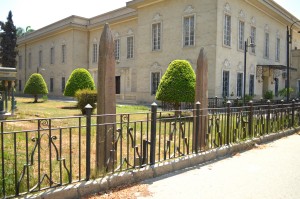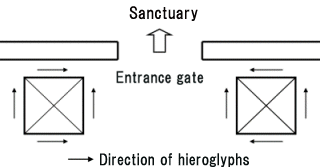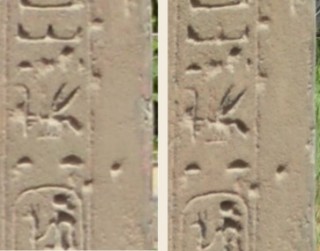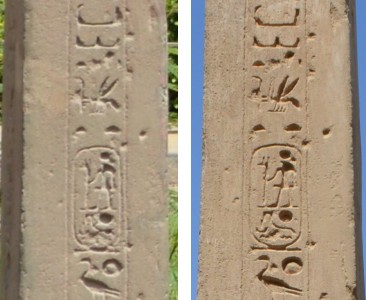|
|
Ramses II Obelisk (Agricultural Museum)
| Present Site: | Dokki District, Giza, Egypt N 30°02'45.8"(30.046049) E 31°12'36.1"(31.210043) |
| Pharaoh: | Replica |
| Measurement: | About 2.2 meters high for the obelisk itself |
| Stone: | Unknown |
About The Site:
Agricultural Museum was established in 1938, has seven (7) museums divided by the theme. Among them, the Ancient Egyptian Agricultural Museum is the best known.
The impetus for my visit of this museum was one picture posted on one website. When I was serching the websites with key words of museum, obelisk, etc., I came across the website of the Agricultural Museum.
 Obelisk which is standing in the museum yard. Obelisk which is standing in the museum yard.Taken from north-west. |
That picture showed me that an obelisk with hieroglyphs was standing in a yard-like place of the Agricultural Museum. So, I thought this might be a "real (authentic)" obelisk which is not known yet in the world, because another website of this museum posted the pictures of Ancient Egyptian Statues, and this museum is a National Museum, and has a long history. However, I was not sure whether this is a "real" obelisk because the resolution of the picture of this obelisk is unfortunately low and I was unable to confirm the contents of the hieroglyphs with this picture.
Then I made a inquiry to Misr travel. Their response said, that is a replica, because many names of Pharaoh (king) are engraved, despite one name is engraved on the obelisk. But I wanted to try to make sure by myself at the same time when I visited to Cairo.
Little foreign tourists visit this museum, but the existence of this museum is well-known by Cairo citizens, since the elementary schools in Cairo put the museum visits into their curriculums. In fact, a taxi driver said to me "That museum is where elementary school children visit. It's rare that the foreigner visits there."
In the museum's yard, there were small-size sphinx and pharaoh's stone statues. At the inside of the "Ancient Egyptian Agricultural Museum", there were also many various stone statues, but especially those which were exhibited in the building were low in perfection, it was obvious at a glance that it was the exhibits for children. The museum has a collection of grains collected from the ancient ruins of Egypt, but I couldn't see those exhibits because I had a later another schedule.
 South side of two obelisks South side of two obelisks
|
How To Get There:
Most museums in Egypt are open 7 days a week, but this Agricultural Museums is closed on Mondays in addition to Friday, so the visitors would better to check it in advance. The Museum is located in the District called Dokki, between downtown Cairo and Giza. The closest station is Dokki on Subway Line #2. You can see the big street intersection with an overpass on the west side of the station, and it's about 700 meters north of the elevated street, Al Dokki Street.
Since this is not a convenient location, using taxi would be better. But it's not a sightseeing spot for the foreigners, so I don't think the taxi drivers would know the destination even if you tell "the Agricultural Museum" in English. It would be better to say to the hotel concierge "I want to go to the Agricultural Museum of Dokki", and ask him for a taxi, or get a note written as an Agricultural Museum in Arabic.
 General rule for the direction of pair obelisk's inscription | |
 Comparing the inscriptions and the scratches |
About The Obelisk:
The obelisk stands near the entrance of the Museum. On the website introducing the Agricultural Museum, only one obelisk was shown, but it was a pair of obelisks in fact.
Also, according to the information from the local travel agency that I had in advance, it was said that many names of Pharaoh (king) are engraved, but actually there is not such a thing, only familiar horus name, coronation name, and birth name of Ramesses II were engraved, and the name of the other Pharaoh was not confirmed. In addition, there was a sign of its having been restored, and the stone color was similar to the red granite. As far as I saw, it was not a fake obelisk.
Due to the wrong information from the travel agency, I was embarrassed whether it's real obelisk or a fake (replica). After I returned to home, when I was carefully reviewing the pictures I took at there, I have learned this obelisk was a replica at last.
The left pictures are for two obelisks taken from the south side. We can easily understand that the hieroglyphs of the same content are engraved in the same direction. This is not unusual as the two obelisks are built with pairs, and hieroglyphs on all sides are directed towards the sanctuary at the back of the temple. But I noticed all the hieroglyphs are directed to the same direction in all the pictures. I had a doubt when I noticed this. because the "symmetry" was considered to be important in ancient Egypt, and all the hieroglyphs on all sides never direct to the same direction. At least the front and back inscriptions must be symmetrical.
Furthermore, the right pictures are the enlarged ones for the part of cartouche of Ramses II's birth name. On the both obelisks, there are scratches like a round dent mark, beside the cartouche. I believe these scratches never happen such incidentally. Therefore, it seemed that two obelisks were duplicated from the same obelisks.
Now that I know it, I tried looking for the original obelisk that was the source of the two obelisks. There are a lot of obelisks of Ramesses II, but it's limited that the comparatively small obelisk, and there are inscriptions on all the 4 sides. So, I soon idetifiled the obelisk which is standing after the entrance of Nubian Museum. Comparing the damages of the inscriptions and the scratches, I could confirm the source was the east side of the obelisk of Nubian Museum, and the obelisk of Agricultural Museum was a copy (replica) of it.
This Ramesses II Obelisk which is now exhibited in the Nubian Museum, has once been a collection of Egyptian Museum in Cairo, before the Nubian Museum was opened in 1997. The picture of the obelisk which was in the Egyptian Museum in Cairo, is posted in the book "The Obelisks of Egypt" by Labib Habachi. Probably, the replica was made at this time.
Finally, I found that this obelisk is a replica. But I think this is a rare case that obelisk which was reproduced faithfully including the scratches. Compared to the original one, the edges of the inscription are slightly blurred and become unclear. I imagine that these obelisks of the Agricultural Museum were probably made by pouring colored cement into the mold after making the mold by silicone gum or similar. This would be a replica specually made for the Agricultural Museum, I think.
Notes For Pictures:
With one picture, searching for the location of the Agricultural Museum, and confirming the obelisk on site, and comparing the pictures of Ramesses II Obelisks which I took, and then finally identified the obelisk of Nubian Museum. This could not without visiting the sites. This was pleasure work which satisfied my intellectual curiosity. It was good as I reached the conclusion.

Comparison of two obelisks: Agricultural Museum at left, Nubian Museum at right |
||||
August 6, 2014 at Agricultural Museum, April 29, 2016 at Nubian Museum by Hiroyuki Nagase (For high definition image, please click the picture) | ||||
Copyright Hiroyuki Nagase nagase@obelisks.org and Shoji Okamoto okamoto@obelisks.org